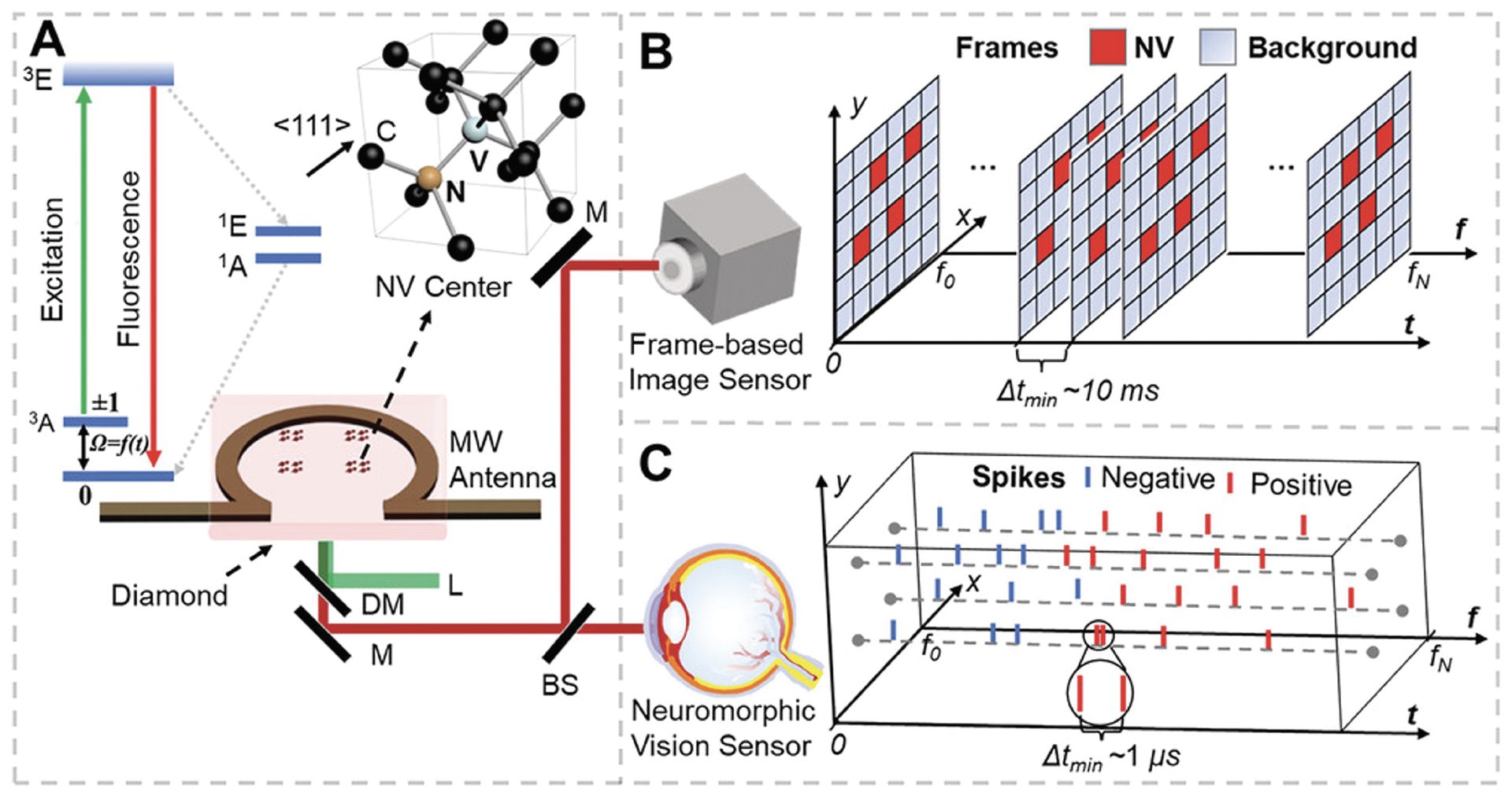bulletin | feature
Enhancing widefield quantum sensing with novel neuromorphic vision sensors
Pictured is the novel diamond widefield quantum sensing setup with neuromorphic vision sensors.
Credit: Madhav Gupta
A novel method of performing widefield quantum sensing using neuromorphic vision sensors may pave the way to further advance the field of quantum sensing.
By Madhav Gupta and Zhiqin Chu
Quantum technologies, such as quantum computing, quantum communications, and quantum sensing, are poised to be among the most revolutionary technologies of the 21st century.
Over the past few decades, a plethora of material systems have been extensively studied and characterized for use in quantum technologies,1,2 such as superconducting systems, trapped ions, ultracold atoms, and quantum dots. Solid-state defect centers in diamond are one of the most promising systems.
Defect centers are tiny imperfections in the diamond’s atomic lattice caused by various factors, for example, missing atoms (carbon vacancies), atoms in places that are typically vacant (interstitial carbon), and the presence of foreign atoms that are not carbon (typically nitrogen). Some of these defects affect the diamond’s optical properties, allowing it to absorb incident radiation with specific energies.
Nitrogen-vacancy (NV) centers, which consist of a nearest-neighbor pair of a nitrogen atom (substituted for a carbon atom) and a lattice vacancy, are one of the most promising types of defect centers for quantum applications due to their exceptional electronic spin properties at room temperature.
Researchers have used NV centers in diamonds to develop quantum sensors that detect magnetic fields, electric fields, or temperatures with extreme sensitivity approaching the quantum limit.3 Quantum sensors based on customized methods, such as confocal and widefield-based fluorescence microscopes, serve as the gold standard for quantum sensing technology.
The widefield diamond quantum sensing approach is particularly desirable because it allows for parallel readout of spatially resolved NV fluorescence. Since the first experimental demonstration in 2010,4 the NV-based widefield quantum sensing platform has developed rapidly and is now deployed for practical applications in various areas, including biomedical, condensed matter physics, and integrated circuit inspecting.
There are several challenges in the field of widefield quantum sensing, though, as explained in the next section. To address these challenges, we explored a novel method of performing widefield quantum sensing that uses neuromorphic vision sensors as the fluorescence detectors instead of the commonly used frame-based cameras (Figure 1).5

Figure 1. A) Overview of NV-based widefield quantum sensing: energy level diagram and atomic structure of NV centers, and the experimental apparatus of widefield quantum diamond microscope. L: laser; DM: dichroic mirror; BS: beam splitter; M: mirror.
B) Schematic showing the working principle of frame-based widefield quantum sensing, in which a series of frames are output from a frame-based sensor recording both fluorescence intensity and background signals.
C) Schematic showing the working principle of proposed neuromorphic widefield quantum sensing, in which fluorescence changes are converted into sparse spikes through a neuromorphic vision sensor.
Credit: Du et al., Advanced Science (CC BY 4.0)
Current challenges in widefield quantum sensing
Simultaneously achieving high temporal resolution and sensitivity remains a key challenge in widefield quantum sensing. This difficulty is largely due to the transfer and processing of massive amounts of data from the frame-based sensor to capture the widefield fluorescence intensity of spin defects in diamonds. This data transfer can significantly limit the temporal resolution, which is typically no more than 100 fps due to the use of frame-based image sensors. As a result, the potential to use widefield quantum sensing for dynamic magnetometric measurements has been exploited only to a limited extent.
Several studies propose different approaches to improve the temporal resolution in widefield quantum sensing, but each approach has its limitations. For example, the down-sampling method may introduce artifacts into the data; frequency multiplexing involves complicated implementation while providing limited speed-up; advanced sensing arrays with single-photon avalanche diodes require complex circuit integration; and in-pixel demodulation with lock-in cameras sacrifices sensing precision. In each case as well, the fundamental limitation still lies in the monitored fluorescence intensity changes with image frames associated with a vast amount of data, leading to unsatisfactory performance in widefield quantum sensing.
Exploring the potential of neuromorphic sensors
To overcome this bottleneck, we propose using a neuromorphic vision camera to pre-process fluorescence intensity data near the sensor device.
Unlike traditional sensors that record light intensity levels, neuromorphic vision sensors process light intensity changes into “spikes” similar to biological vision systems. Additionally, the neuromorphic pixels work independently and asynchronously, enabling the immediate readout of detected fluorescence change without waiting for the other pixels. These features of neuromorphic vision sensors result in highly compressed data volume and reduced latency, which allow for significantly enhanced temporal resolution (≈µs) and dynamic range (>120 dB).
Neuromorphic vision sensors are also effective in scenarios where image changes are infrequent, such as object tracking, because the event data that constitute the time-varying fluorescence spectrum are generated only when the light change surpasses a threshold. This requirement reduces redundant static background signals and overcomes the limitations of frame rate in the frame-based approaches, enabling low-latency measurements.
This study, to the best of our knowledge, is the first to use neuromorphic vision sensors to perform wide-field diamond quantum sensing.5 We started by conducting a thorough theoretical evaluation to demonstrate the feasibility of our idea and to guide our following experiments. We then adapted an off-the-shelf neuromorphic event camera and compared it to a state-of-the-art highly specialized frame-based camera.
Our neuromorphic method demonstrated a 13× improvement in temporal resolution with comparable precision as compared with the frame-based approach. We also successfully used this technology to monitor dynamically modulated laser heating of gold nanoparticles coated on a diamond surface, a recognizably difficult task using existing approaches.
Conclusion
The essence of widefield quantum sensing is to detect changes in the number of photons across space and time, presenting a complex trade-off in both spatial and temporal domains. Our event-based working process offers the ability to detect sparse events adaptively in both space and time, thus matching well with the requirement of quantum sensing.
We anticipate that our proposed method will revolutionize widefield quantum sensing, significantly improving performance at an affordable cost. Our study also has significant potential for further development in other applications. For example, in addition to its application in dynamic temperature measurement, it can be readily extended to magnetic field sensing, which has implications for the manipulation of magnetic skyrmions, spin-assisted super-resolution imaging, and detection of neuron action potential, among other possibilities.
Furthermore, neural network algorithms could be used to map the raw events back to the original spectrum because they preserve the derivative function relationship, i.e., directly infer the observables, such as temperature and magnetic field, potentially optimizing the precision further. Integration of electronic synapse devices could also enable in-sensor or near-sensor algorithm execution, paving the way for the development of intelligent quantum sensors.
We are excited to witness the new opportunities in scientific research and practical applications that our study brings.
